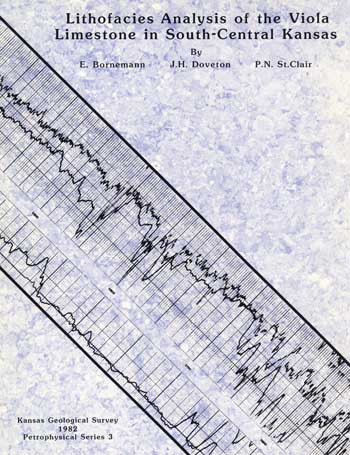Lithofacies analysis of the Viola Limestone in South-central Kansas
DOI:
https://doi.org/10.17161/kgsbulletin.no..23590Abstract
Core and cuttings studies of the Viola Limestone (Middle to Upper Ordovician) in south-central Kansas were integrated with numerical analyses of wireline logs in a composite evaluation of lithofacies variation. Two basic end-member facies were recognized; a low-porosity limestone of crinoidal packstones and grainstones, and a moderately porous cherty dolomitic limestone representing dolomitized wackestones and mudstones. These facies can be traced from both cuttings profiles and wireline log traces across the area as correlative subdivisions of the Viola. Fourier analysis of fine-scale variation of log-derived mineralogy suggests that facies migration was cyclic rather than episodic, in response to either an eustatic or tectonic control.
Lateral changes in facies, as interpreted from core cuttings, show a basic parallelism with the Central Kansas Arch. These range outwards from a somewhat restricted facies of sparsely fossiliferous wackestones and mudstones to crinoid packstones and grainstones representative of higher energy, open-marine environments. The influence of the Pratt Anticline as a positive feature contemporaneous with deposition is suggested in the upper Viola from core evidence and in the lower Viola from log analysis. In both instances, these appear as a relative enhancement of a calcite mud component on the structural axis, which graded outwards to less micritic higher energy facies on the flanks.
Computer processing of neutron, sonic, and density logs resulted in an interpretative lithofacies map in which the patterns reflect a complex history of deposition, diagenesis, and erosion. The disposition of limestone and dolomite facies as the dominant aspect of the Viola was dictated by erosional bevelling of the formation in Devonian and early Pennsylvanian times. On a regional scale, the Viola thins to the east with marked local variation controlled by differential fault-block movement. The lithofacies may also outline a region which represents solution weathering of the Viola to produce karstic carbonate zones and extensive deposits of residual chert. The map shows a distinctive grain which coincides with southerly continuations of fault trends associated with the Precambrian Central North American Rift System. These faults appear to have been intermittently active throughout the Paleozoic, influencing depositional trends, diagenetic patterns, erosional history, and the location of traps for Viola oil fields.

Downloads
Published
Issue
Section
License
Copyright (c) 2025 E. Bornemann, J.H. Doveton , P.N. St. Clair

This work is licensed under a Creative Commons Attribution-NonCommercial 4.0 International License.
